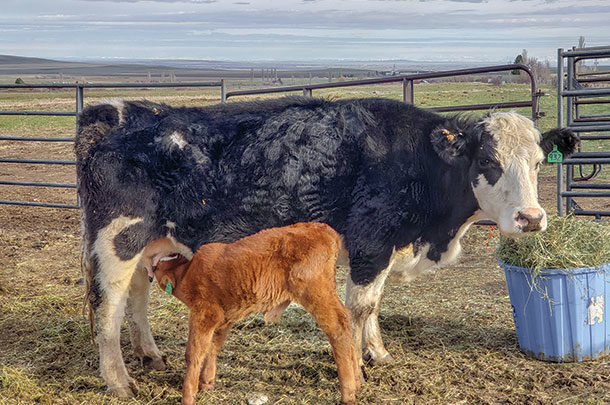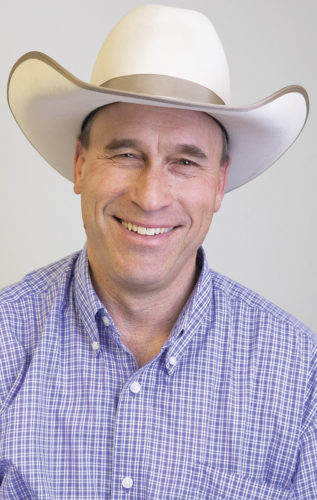It was shaping up to be a good spring day. The snow was pretty much gone, and the mud was drying up. It was one of the first days of the year that dared me to attack it without the aid of muck boots or snow packs on my feet. The light gray clouds in the sky danced with the wind and the sun, a ballet that enticed me to leave my coat in the pickup if not in the closet back at the house.
We were a couple of weeks into calving and were getting several calves a day. For the most part, luck had been on my side. Apart from a couple of bitter cold nights to start things off, we’d survived to that point without anything I’d classify as a wreck. I’d doctored a few for scours, so I was a little on edge, but we weren’t losing them.
I stopped in at the house for a quick lunch before we set back out to string up a hot wire around a corner of the southwest pivot where we were keeping a little bunch of heifers. Before we started with the project, I figured we should make a quick trip through the biggest herd of cows just to see if we needed to tag one or two new calves.
As the old pickup bounced across the ruts and brush, my eye was drawn to the far corner of the field, where an ominous scene was unfolding. I’d noticed the big old Simmy-cross cow earlier in the day. I expected her to calve that day. What I didn’t expect was what I found. She was one of the marker cows: big, black, white-faced with the old traditional Simmental markings you don’t see much of any more. She never raised much of a calf, but I kept her around, thinking she may someday produce a show-worthy 4-H calf.
As we approached, I could see my anticipated yet unwelcomed wreck had arrived. The old cow lay there on her left side, legs outstretched and a 120-pound calf shivering behind her. What distressed me was the full uterine prolapse that accompanied the calf. My heart sank as I beheld the scene.
“Do you want to call the vet?” my dad asked.
I answered in the negative. It was Saturday afternoon, and I figured Trevor, the ever-patient vet, would be at a roping in Pocatello or anywhere else where he could catch his breath and a break from his country vet dream life. As much as I wanted to outsource this burdensome project, I figured I could at least save a dollar or two, since I figured she’d die anyway.
There is no metaphor or simile or analogy to properly describe a full-blown bovine uterine prolapse and its treatment. It’s what you use to describe some other unfathomable task. When Sir Edmund Hillary asked what ascending Everest would be like, his Sherpa guide no doubt told him it was akin to fixing a prolapsed cow.
I raced back to the barn to fetch the umbilical tape and a needle. I had nothing to give for a spinal block, so I could only hope the old girl wouldn’t fight too much. I needed a little fight in her but not so much it made the job more impossible than it already seemed. She did indeed have enough fight in her to stand up and try to trot away. I roped her, got a halter on her and tied her to the back of the pickup. At least she could stand. I’d at least have a little bit of gravity to help me.
Two hands are hardly enough to start the job, so my 82-year-old father gloved up and dove into the fray with me. All you can do is start the job and practice a little faith and trust in what you’re doing. You just keep working, a millimeter at a time, and amid the doubts, anxiety and fear, you eventually see some progress. Really, though, it doesn’t seem like you see any progress until somehow, miraculously, everything is back in place.
The clock said 35 minutes had passed. It was an eternally long half-hour, but we got the job done. The working conditions were just slightly less than sterile, so I loaded the cow up with antibiotics and stitched her up, all the while praying everything didn’t go inside out again. I wouldn’t have bet the farm on it, but the old girl survived. So did the calf. As desperate as the situation seemed, we all came through it.
I couldn’t help but think of this miniature personal struggle as I’ve watched the massive and tragic devastation in the wake of Mother Nature’s powerful theatrics in Australia and America’s Heartland these past months. I’ve been hesitant to mention it in my insignificant prose because I am vastly underqualified and overwhelmed. My finite ability to comprehend the tragedy of it all hardly allows me to lend any commentary at all.
Yet I hear of and see people who have been ravaged and deeply impacted by these catastrophic events rise up and take their own brand of fight to the battle before they’ve even had a chance to put on a pair of dry socks. It gives me hope. Hope in not only their recovery but in all of us and our ability to overcome devastation, weakness and pettiness. They’re fighting on, one millimeter at a time.








